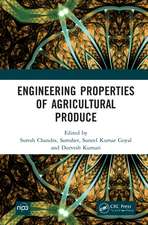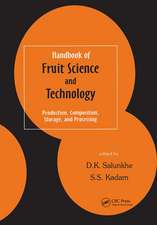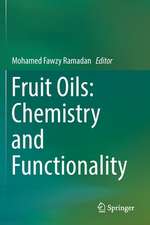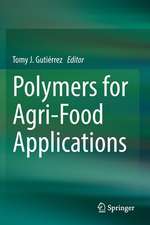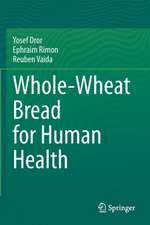An Introduction to the Physical Chemistry of Food: Food Science Text Series
Autor John N. Couplanden Limba Engleză Hardback – 30 iun 2014
This textbook introduces the physical chemistry essential to understanding the behavior of foods. Starting with the simplest model of molecules attracting and repelling one another while being moved by the randomizing effect of heat, the laws of thermodynamics are used to derive important properties of foods such as flavor binding and water activity. Most foods contain multiple phases and the same molecular model is used to understand phase diagrams, phase separation and the properties of surfaces. The remaining chapters focus on the formation and properties of specific structures in foods – crystals, polymers, dispersions and gels.
Only a basic understanding of food science is needed, and no mathematics or chemistry beyond the introductory college courses is required. At all stages, examples from the primary literature are used to illustrate the text and to highlight the practical applications of physical chemistry in food science.
| Toate formatele și edițiile | Preț | Express |
|---|---|---|
| Paperback (1) | 496.99 lei 6-8 săpt. | |
| Springer – 3 sep 2016 | 496.99 lei 6-8 săpt. | |
| Hardback (1) | 532.70 lei 6-8 săpt. | |
| Springer – 30 iun 2014 | 532.70 lei 6-8 săpt. |
Din seria Food Science Text Series
- 17%
 Preț: 502.95 lei
Preț: 502.95 lei - 17%
 Preț: 469.18 lei
Preț: 469.18 lei - 15%
 Preț: 549.39 lei
Preț: 549.39 lei - 20%
 Preț: 579.80 lei
Preț: 579.80 lei -
 Preț: 458.78 lei
Preț: 458.78 lei - 15%
 Preț: 566.10 lei
Preț: 566.10 lei - 13%
 Preț: 358.75 lei
Preț: 358.75 lei - 15%
 Preț: 635.75 lei
Preț: 635.75 lei -
 Preț: 396.40 lei
Preț: 396.40 lei -
 Preț: 482.23 lei
Preț: 482.23 lei -
 Preț: 392.37 lei
Preț: 392.37 lei -
 Preț: 398.35 lei
Preț: 398.35 lei - 15%
 Preț: 508.60 lei
Preț: 508.60 lei - 15%
 Preț: 508.75 lei
Preț: 508.75 lei - 15%
 Preț: 587.39 lei
Preț: 587.39 lei - 18%
 Preț: 965.83 lei
Preț: 965.83 lei -
 Preț: 393.13 lei
Preț: 393.13 lei - 15%
 Preț: 593.26 lei
Preț: 593.26 lei -
 Preț: 474.31 lei
Preț: 474.31 lei - 15%
 Preț: 658.05 lei
Preț: 658.05 lei - 15%
 Preț: 600.74 lei
Preț: 600.74 lei - 18%
 Preț: 971.22 lei
Preț: 971.22 lei - 15%
 Preț: 477.74 lei
Preț: 477.74 lei - 18%
 Preț: 1010.33 lei
Preț: 1010.33 lei - 15%
 Preț: 477.74 lei
Preț: 477.74 lei - 15%
 Preț: 574.25 lei
Preț: 574.25 lei
Preț: 532.70 lei
Preț vechi: 626.70 lei
-15% Nou
Puncte Express: 799
Preț estimativ în valută:
101.93€ • 106.71$ • 84.34£
101.93€ • 106.71$ • 84.34£
Carte tipărită la comandă
Livrare economică 05-19 aprilie
Preluare comenzi: 021 569.72.76
Specificații
ISBN-13: 9781493907601
ISBN-10: 1493907603
Pagini: 182
Ilustrații: XIII, 182 p. 182 illus., 7 illus. in color.
Dimensiuni: 178 x 254 x 17 mm
Greutate: 0.56 kg
Ediția:2014
Editura: Springer
Colecția Springer
Seria Food Science Text Series
Locul publicării:New York, NY, United States
ISBN-10: 1493907603
Pagini: 182
Ilustrații: XIII, 182 p. 182 illus., 7 illus. in color.
Dimensiuni: 178 x 254 x 17 mm
Greutate: 0.56 kg
Ediția:2014
Editura: Springer
Colecția Springer
Seria Food Science Text Series
Locul publicării:New York, NY, United States
Public țintă
Upper undergraduateCuprins
Introduction.- Kinetics and Thermodynamics.- Simple Solutions.- Crystallization.- Surfactants.- Polymers.- Gels.- Surfaces.- Multiphase systems.- Index
Recenzii
From the book reviews:
“This reviewer … gained more practical knowledge here than from any other science book he has read. As Coupland presents information relating thermodynamic properties to molecular behavior, he includes very insightful examples, all food-related. They make the topic come alive and more relevant to the real world than other science texts. … This very enjoyable, informative work is also useful for anyone with an interest or background in physical chemistry. Summing Up: Highly recommended. Upper-division undergraduates and above.” (J. Allison, Choice, Vol. 52 (6), February, 2015)
“This reviewer … gained more practical knowledge here than from any other science book he has read. As Coupland presents information relating thermodynamic properties to molecular behavior, he includes very insightful examples, all food-related. They make the topic come alive and more relevant to the real world than other science texts. … This very enjoyable, informative work is also useful for anyone with an interest or background in physical chemistry. Summing Up: Highly recommended. Upper-division undergraduates and above.” (J. Allison, Choice, Vol. 52 (6), February, 2015)
Notă biografică
John Coupland is a Professor of Food Science at Penn State where he teaches food chemistry and the physical chemistry of foods. His research is largely focused on food colloids.
Textul de pe ultima copertă
Familiar combinations of ingredients and processing make the structures that give food its properties. For example, in ice cream the emulsifiers and proteins stabilize partly crystalline milk fat as an emulsion, freezing (crystallization) of some of the water gives the product its hardness, and polysaccharide stabilizers keep it smooth. Why different recipes work as they do is largely governed by the rules of physical chemistry.
This textbook introduces the physical chemistry essential to understanding the behavior of foods. Starting with the simplest model of molecules attracting and repelling one another while being moved by the randomizing effect of heat, the laws of thermodynamics are used to derive important properties of foods such as flavor binding and water activity. Most foods contain multiple phases, and the same molecular model is used to understand phase diagrams, phase separation, and the properties of surfaces. The remaining chapters focus on the formation and properties of specific structures in foods – crystals, polymers, dispersions and gels.
Only a basic understanding of food science is needed, and no mathematics or chemistry beyond the introductory college courses is required. At all stages, examples from the primary literature are used to illustrate the text and to highlight the practical applications of physical chemistry in food science.
John Coupland is a Professor of Food Science at Penn State where he teaches food chemistry and the physical chemistry of foods. His research is largely focused on food colloids.
This textbook introduces the physical chemistry essential to understanding the behavior of foods. Starting with the simplest model of molecules attracting and repelling one another while being moved by the randomizing effect of heat, the laws of thermodynamics are used to derive important properties of foods such as flavor binding and water activity. Most foods contain multiple phases, and the same molecular model is used to understand phase diagrams, phase separation, and the properties of surfaces. The remaining chapters focus on the formation and properties of specific structures in foods – crystals, polymers, dispersions and gels.
Only a basic understanding of food science is needed, and no mathematics or chemistry beyond the introductory college courses is required. At all stages, examples from the primary literature are used to illustrate the text and to highlight the practical applications of physical chemistry in food science.
John Coupland is a Professor of Food Science at Penn State where he teaches food chemistry and the physical chemistry of foods. His research is largely focused on food colloids.
Caracteristici
Acts as a support for readings from the primary literature in an advanced (graduate level) class Great resource for any food scientist in understanding why food behaves as it does Plethora of real-life examples highlights the application of physical chemistry in food science Includes supplementary material: sn.pub/extras



